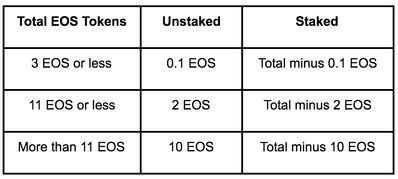In this piece, we will learn everything we need to know about staking and unstaking EOS tokens. The staking mechanism makes EOS special and efficient so it’s important to understand the meaning of staking / unstaking.

CPU & Network Bandwidth and RAM
On EOS people deal with three resources: memory (RAM), CPU bandwidth, and Network bandwidth. As Network and CPU are transient by default they are staked allocation. Users consume Network or CPU bandwidth any time, and then these resources always refill. That's the reason why users don't have to purchase CPU and Network bandwidth while RAM requires purchasing.
CPU bandwidth represents the time (in microseconds) taken by the processing of some action. Each transaction requires some time, and this time is subtracted from the sender's allocation for a while, then it gets regenerated.
Network bandwidth expresses the throughput capacity of the EOS network in bytes, and when the transaction takes place the sender provides some network capacity from his/her allocation, and then this resource gets refilled, too.
RAM is what users need to maintain decent capacity for smooth execution of any number of transactions. Obviously, it's good to have as much RAM as possible.
When using CPU and Network bandwidth user's staked EOS tokens are returned, and the amount stays the same while using RAM is not free. The price depends on the amount of RAM that is not currently used by anyone in the network so users can both benefit or lose a little because of this volatility. Actually, it was made by design in order to encourage people to release their RAM when they don't use it.
Staked Tokens
Simply put, a staked token is a token that can't be used for a while, a locked up token. For example, if the token gets staked towards CPU the user gets allocated a proper amount of CPU bandwidth for the length of time while the token is kept staked. When the user unstakes the token, it takes 72 hours to unlock this token, but the access to the bandwidth gets suspended immediately. On the EOS blockchain, the operation of staking/unstaking is called delegatingbw / undelegatingbw.
Each account has staked coins from the very beginning in order to make it possible to cast votes or process the transactions. The amounts are set as follows:

In most cases having 1 to 2 EOS staked tokens is enough to interact with the platform actively. For those who intend to make a couple of transactions per day or even less, having half of a token staked is good enough.
Different EOS wallets have different interfaces for staking and unstaking tokens. In most cases, the process is intuitive.
When users unstake their coins, the EOS tokens are held on eosio.stake account for three days for security reasons.
What's Good About Staking Tokens?
Staking coins has no straightforward economic effect on users. First of, staking tokens provides users with the voting weight. Voting on EOS is a very important part of the process because it keeps the network relevant and updates the list of Block Producers who govern the entire ecosystem. More than that, staking tokens provides users with some CPU and Network bandwidth, as it was mentioned before.
What makes staking approach special is that it allows making transactions without paying fees, while securing the network from overload caused by spam transactions. Both features make EOS comfortable, efficient and accessible.